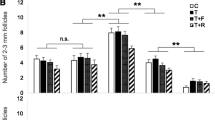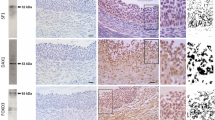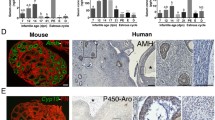Abstract
Excess of prenatal testosterone (T) induces reproductive defects including follicular persistence. Comparative studies with T and dihydrotestosterone (DHT) have suggested that follicular persistence is programmed via estrogenic actions of T. This study addresses the androgenic and estrogenic contributions in programming follicular persistence. Because humans are exposed to estrogenic environmental steroids from various sources throughout their life span and postnatal insults may also induce organizational and/or activational changes, we tested whether continuous postnatal exposure to estradiol (E) will amplify effects of prenatal steroids on ovarian function. Pregnant sheep were treated with T, DHT, E, or ED (E and DHT) from days 30 to 90 of gestation. Postnatally, a subset of the vehicle (C), T, and DHT females received an E implant. Transrectal ultrasonography was performed in the first breeding season during a synchronized cycle to monitor ovarian follicular dynamics. As expected, number of ≥8 mm follicles was higher in the T versus C group. Postnatal E reduced the number of 4 to 8 mm follicles in the DHT group. Percentage of females bearing luteinized follicles and the number of luteinized follicles differed among prenatal groups. Postnatal E increased the incidence of subluteal cycles in the prenatal T-treated females. Findings from this study confirm previous findings of divergences in programming effects of prenatal androgens and estrogens. They also indicate that some aspects of follicular dynamics are subject to postnatal modulation as well as support the existence of an extended organizational period or the need for a second insult to uncover the previously programmed event.
Similar content being viewed by others
References
Sawyer HR, Smith P, Heath DA, Juengel JL, Wakefield SJ, McNatty KP. Formation of ovarian follicles during fetal development in sheep. Biol Reprod. 2002;66(4):1134–1150.
Kerr JB, Brogan L, Myers M, et al. The primordial follicle reserve is not renewed after chemical or gamma-irradiation mediated depletion. Reproduction. 2012;143(4):469–476.
Rodriguez HA, Santambrosio N, Santamaría CG, Munoz-de-Toro M, Luque EH. Neonatal exposure to bisphenol A reduces the pool of primordial follicles in the rat ovary. Reprod Toxicol. 2010; 30(4):550–557.
Padmanabhan V, Veiga-Lopez A. Developmental origin of reproductive and metabolic dysfunctions: androgenic versus estrogenic reprogramming. Semin Reprod Med. 2011;29(3):173–186.
Smith P, Steckler TL, Veiga-Lopez A, Padmanabhan V. Developmental programming: differential effects of prenatal testosterone and dihydrotestosterone on follicular recruitment, depletion of follicular reserve, and ovarian morphology in sheep. Biol Reprod. 2009;80(4):726–736.
Padmanabhan V, Smith P, Veiga-Lopez A. Developmental programming: impact of prenatal testosterone treatment and postnatal obesity on ovarian follicular dynamics. J Dev Health Dis. 2012;3(4):276–286.
Manikkam M, Steckler TL, Welch KB, Inskeep EK, Padmanabhan V. Fetal programming: prenatal testosterone treatment leads to follicular persistence/luteal defects; partial restoration of ovarian function by cyclic progesterone treatment. Endocrinology. 2006; 147(4): 1997–2007.
West C, Foster DL, Evans NP, Robinson J, Padmanabhan V. Intrafollicular activin availability is altered in prenatally-androgenized lambs. Mol Cell Endocrinol. 2001;185(1–2):51–59.
Steckler T, Manikkam M, Inskeep EK, Padmanabhan V. Developmental programming: follicular persistence in prenatal testosterone-treated sheep is not programmed by androgenic actions of testosterone. Endocrinology. 2007;148(7):3532–3540.
Dickerson SM, Gore AC. Estrogenic environmental endocrine-disrupting chemical effects on reproductive neuroendocrine function and dysfunction across the life cycle. Rev Endocr Metab Disord. 2007;8(2):143–159.
Latini G, Knipp G, Mantovani A, Loredana M, Chiarelli F, Söder O. Endocrine disruptors and human health. Mini Rev Med Chem. 2010;10(9):846–855.
Bayer TA, Falkai P, Maier W. Genetic and non-genetic vulnerability factors in schizophrenia: the basis of the “two hit hypothesis”. J Psychiatr Res. 1999;33(6):543–548.
Steckler TL, Herkimer C, Dumesic DA, Padmanabhan V. Developmental programming: excess weight gain amplifies the effects of prenatal testosterone excess on reproductive cyclicity—implication for polycystic ovary syndrome. Endocrinology. 2009; 150(3):1456–1465.
Veiga-Lopez A, Ye W, Phillips DJ, Herkimer C, Knight PG, Padmanabhan V. Developmental programming: deficits in reproductive hormone dynamics and ovulatory outcomes in prenatal, testosterone-treated sheep. Biol Reprod. 2008;78(4):636–647.
Adams NR. Detection of the effects of phytoestrogens on sheep and cattle. J Anim Sci. 1995;73(5):1509–1515.
Manikkam M, Crespi EJ, Doop DD, et al. Fetal programming: prenatal testosterone excess leads to fetal growth retardation and postnatal catch-up growth in sheep. Endocrinology. 2004;145(2): 790–798.
Masek KS, Wood RI, Foster DL. Prenatal dihydrotestosterone differentially masculinizes tonic and surge modes of luteinizing hormone secretion in sheep. Endocrinology. 1999;140(8):3459–3466.
Foster DL. Preovulatory gonadotropin surge system of prepubertal female sheep is exquisitely sensitive to the stimulatory feedback action of estradiol. Endocrinology. 1984;115(3): 1186–1189.
Goodman RL, Legan SJ, Ryan KD, Foster DL, Karsch FJ. Two effects of estradiol that normally contribute to the control of tonic LH secretion in the ewe. Biol Reprod. 1980;23(2):415–422.
Padmanabhan V, Evans NP, Dahl GE, McFadden KL, Mauger DT, Karsch FJ. Evidence for short or ultrashort loop negative feedback of gonadotropin-releasing hormone secretion. Neuroendocrinology. 1995;62(3):248–258.
Campbell BK, Scaramuzzi RJ, Webb R. Control of antral follicle development and selection in sheep and cattle. J Reprod Fert Supplement. 1995;49:335–350.
Driancourt MA. Regulation of ovarian follicular dynamics in farm animals. Implications for manipulation of reproduction. Theriogenology. 2001;55(6):1211–1239.
Hunter MG, Robinson RS, Mann GE, Webb R. Endocrine and paracrine control of follicular development and ovulation rate in farm species. Anim Reprod Sci. 2004;82–83:461–477.
Flynn JD, Duffy P, Boland MP, Evans AC. Progestagen synchronisation in the absence of a corpus luteum results in the ovulation of a persistent follicle in cyclic ewe lambs. Anim Reprod Sci. 2000;62(4):285–296.
Ginther OJ, Kot K, Wiltbank MC. Associations between emergence of follicular waves and fluctuations in FSH concentrations during the estrous cycle in ewes. Theriogenology. 1995;43(3): 689–703.
Wright C, Evans AC, Evans NP, et al. Effect of maternal exposure to the environmental estrogen, octylphenol, during fetal and/or postnatal life on onset of puberty, endocrine status, and ovarian follicular dynamics in ewe lambs. Biol Reprod. 2002;67(6):1734–1740.
Killick S, Elstein M. Pharmacologic production of luteinized unruptured follicles by prostaglandin synthetase inhibitors. Fertil Steril. 1987;47(5):773–777.
Coetsier T, Dhont M. Complete and partial luteinized unruptured follicle syndrome after ovarian stimulation with clomiphene citrate/human menopausal gonadotrophin/human chorionic gonadotrophin. Hum Reprod. 1996;11(3):583–587.
D’Hooghe TM, Bambra CS, Raeymaekers BM, Koninckx PR. Increased incidence and recurrence of recent corpus luteum without ovulation stigma (luteinized unruptured follicle syndrome?) in baboons with endometriosis. J Soc Gynecol Investig. 1996;3(3): 140–144.
Cuervo-Arango J, Newcombe JR. Ultrasound characteristics of experimentally induced luteinized unruptured follicles (LUF) and naturally occurring hemorrhagic anovulatory follicles (HAF) in the mare. Theriogenology. 2012;77(3):514–524.
Murdoch WJ, Dunn TG. Luteal function after ovulation blockade by intrafollicular injection of indomethacin in the ewe. J Reprod Fertil. 1983;69(2):671–675.
Ginther OJ, Gastal MO, Gastal EL, Jacob JC, Beg MA. Induction of haemorrhagic anovulatory follicles in mares. Reprod Fertil Dev. 2008;20(8):947–954.
Cuervo-Arango J, Newcombe JR. The effect of hormone treatments (hCG and cloprostenol) and season on the incidence of hemorrhagic anovulatory follicles in the mare: a field study. Theriogenology. 2009;72(9):1262–1267.
Sirois J, Dore M. The late induction of prostaglandin G/H synthase-2 in equine preovulatory follicles supports its role as a determinant of the ovulatory process. Endocrinology. 1997; 138(10):4427–4434.
Sarma HN, Manikkam M, Herkimer C, et al. Fetal programming: excess prenatal testosterone reduces postnatal luteinizing hormone, but not follicle-stimulating hormone responsiveness, to estradiol negative feedback in the female. Endocrinology. 2005; 146(10):4281–4291.
Manikkam M, Thompson RC, Herkimer C, et al. Developmental programming: impact of prenatal testosterone excess on pre- and postnatal gonadotropin regulation in sheep. Biol Reprod. 2008; 78(4):648–660.
Ortega HH, Salvetti NR, Padmanabhan V. Developmental programming: prenatal androgen excess disrupts ovarian steroid receptor balance. Reproduction. 2009;137(5):865–877.
Ortega HH, Rey F, Velazquez MM, Padmanabhan V. Developmental programming: effect of prenatal steroid excess on intraovarian components of insulin signaling pathway and related proteins in sheep. Biol Reprod. 2010;82(6):1065–1075.
Salvetti NR, Ortega HH, Veiga-Lopez A, Padmanabhan V. Developmental programming: impact of prenatal testosterone excess on ovarian cell proliferation and apoptotic factors in sheep. Biol Reprod. 2012;87(1):22, 21–10.
Pangas SA, Li X, Robertson EJ, Matzuk MM. Premature luteinization and cumulus cell defects in ovarian-specific Smad4 knockout mice. Mol Endocrinol. 2006;20(6):1406–1422.
Luense LJ, Veiga-Lopez A, Padmanabhan V, Christenson LK. Developmental programming: gestational testosterone treatment alters fetal ovarian gene expression. Endocrinology. 2011;152(12):4974–4983.
van den Hurk R, Zhao J. Formation of mammalian oocytes and their growth, differentiation and maturation within ovarian follicles. Theriogenology. 2005;63(6):1717–1751.
George FW, Wilson JD. Sex determination and differentiation. In: Knobil E, Neill JD, eds. The Physiology of Reproduction. New York, NY: Raven Press; 1994:3–28.
Veiga-Lopez A, Astapova OI, Aizenberg EF, Lee JS, Padmanabhan V. Developmental programming: contribution of prenatal androgen and estrogen to estradiol feedback systems and periovulatory hormonal dynamics in sheep. Biol Reprod. 2009;80(4):718–725.
Hillier SG, Tetsuka M, Fraser HM. Location and developmental regulation of androgen receptor in primate ovary. Hum Reprod. 1997;12(1):107–111.
Billig H, Furuta I, Hsueh AJ. Estrogens inhibit and androgens enhance ovarian granulosa cell apoptosis. Endocrinology. 1993; 133(5):2204–2212.
Hillier SG, Ross GT. Effects of exogenous testosterone on ovarian weight, follicular morphology and intraovarian progesterone concentration in estrogen-primed hypophysectomized immature female rats. Biol Reprod. 1979;20(2):261–268.
Rivera OE, Varayoud J, Rodriguez HA, Munoz-de-Toro M, Luque EH. Neonatal exposure to bisphenol A or diethylstilbestrol alters the ovarian follicular dynamics in the lamb. Reprod Toxicol. 2011;32(3):304–312.
Jackson LM, Timmer KM, Foster DL. Organizational actions of postnatal estradiol in female sheep treated prenatally with testosterone: programming of prepubertal neuroendocrine function and the onset of puberty. Endocrinology. 2009;150(5): 2317–2324.
Murphy BD. Models of luteinization. Biol Reprod. 2000;63(1):2–11.
Richards JS, Russell DL, Robker RL, Dajee M, Alliston TN. Molecular mechanisms of ovulation and luteinization. Mol Cell Endocrinol. 1998;145(1–2):47–54.
Sharma TP, Herkimer C, West C, et al. Fetal programming: prenatal androgen disrupts positive feedback actions of estradiol but does not affect timing of puberty in female sheep. Biol Reprod. 2002;66(4):924–933.
Schug TT, Janesick A, Blumberg B, Heindel JJ. Endocrine disrupting chemicals and disease susceptibility. J Steroid Biochem Mol Biol. 2011;127(3–5):204–215.
Author information
Authors and Affiliations
Corresponding author
Rights and permissions
About this article
Cite this article
Veiga-Lopez, A., Wurst, A.K., Steckler, T.L. et al. Developmental Programming: Postnatal Estradiol Amplifies Ovarian Follicular Defects Induced by Fetal Exposure to Excess Testosterone and Dihydrotestosterone in Sheep. Reprod. Sci. 21, 444–455 (2014). https://doi.org/10.1177/1933719113503412
Published:
Issue Date:
DOI: https://doi.org/10.1177/1933719113503412




